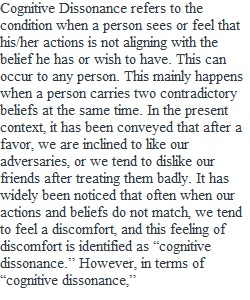


Q Objective Discuss the conditions that elicit dissonance and what strategies we use to reduce dissonance. Instructions: 1. First, review unit six reading assignment, lesson and the clip of Bill Nye's "Cognitive Dissonance." 2. Finally, please respond to the following prompt: How would a dissonance theorist explain the paradoxical finding that we are apt to like our adversaries after doing them a favor, and to dislike our friends after treating them badly? Provide a concrete example. For additional assignment information for Discussion Questions, please refer to the Forum Participation Canvas page. Additionally, you may review the PDF Discussion Question Five Point Rubric download ________________________________________ Questions? Please feel free to post your question to our forum, and a classmate or I will respond with an explanation. Here is the direct link to Student Questions
View Related Questions